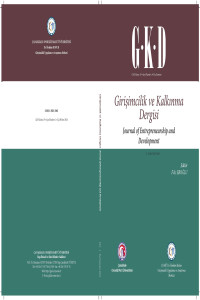Öz
Çalışmada uluslararası ve ulusal göstergelerinin Türk Bankacılık sektöründe bulunan Eurobondların değeri ile ilişkisinin detaylı olarak belirlenmesi amaçlanmıştır. Bu amaç doğrultusunda Aralık 2002 – Nisan 2024 tarihleri arasında, 7 uluslararası ve 7 ulusal gösterge ile Türk Bankacılık sektöründe bulunan Eurobondların değeri arasındaki ilişkiler simetrik ve asimetrik olarak Pata ve Yılancı (2020) Kesirli Frekanslı Esnek Fourier Formunda Toda ve Yamamoto (FFFF-TY) nedensellik testi ile analiz edilmiştir. Elde edilen sonuçlara göre uluslararası ve ulusal göstergeler ile Eurobondların değeri arasında asimetrik bir ilişki yapısı bulunmaktadır. Çalışmada uluslararası göstergelerden TED spreadinde azalıştan ve Amerika Birleşik Devletleri 10 yıl vadeli hazine tahvili faiz oranında artıştan Türk Bankacılık sektöründe bulunan Eurobondların değerine nedensellik ilişkisi belirlenmiştir. Ulusal göstergelerden ise Türk Bankacılık sektörü karlılığında, reel efektif döviz kurunda, USD / TL kurunda, Türkiye 5 yıllık kredi temerrüt takas primindeki azalışlardan ve Türk Bankacılık sektörü karlılığında artıştan Türk Bankacılık sektöründe bulunan Eurobondların değerine ilişkiler tespit edilmiştir. Ulaşılan diğer önemli bulgu, literatürde yer alan birçok çalışmadan farklı olarak ulusal göstergelerin uluslararası göstergelere göre Eurobondların değeri ile ilişkili olmasıdır. Çalışma ile ayrıca söz konusu ilişkilerin kalıcı yapıda olduğu da belirlenmiştir.
Anahtar Kelimeler
Bankacılık sektörü Eurobond değeri Asimetrik ilişki Yapısal değişim Nedensellik testi
Kaynakça
- AHMAD, A. H., & FANELLİ, S. (2014). “Fiscal sustainability in the euro-zone: Is there a role for euro-bonds?”. Atlantic Economic Journal, 42(3), 291 – 303. https://doi.org/10.1007/s11293-014-9416-4
- AKKAYA, M. (2018). “Türk Euro Tahvillerinin Risk Primlerini Etkileyen İçsel Faktörlerin Analizi”. Journal of Yaşar University, 13(50), 231 – 241. https://doi.org/10.19168/jyasar.378124
- AKKAYA, M. (2019). “An Analysis of The Factors Affecting The Risk Premium of Turkish Eurobonds”. III. Taras Shevchenk, International Congress on Social Sciences. Kiev, Ukrayna.
- BOTTA, A. (2013). “Fiscal policy, eurobonds, and economic recovery: Heterodox policy recipes against financial instability and sovereign debt crisis”. Journal of Post Keynesian Economics, 35(3), 417 – 442. https://doi.org/10.2753/pke0160-3477350305BUKET,
- B. M. (2009). “Türkiye’de Eurotahvil Uygulaması ve Eurotahvil Getiri Marjlarını Belirleyen Faktörler (Yayınlanmamış doktora tezi)”. Kadir Has Üniversitesi, İstanbul
- BURSA, N., & TATLIDİL, H. (2015). “Risk Göstergelerine Çok Değişkenli Analiz Yaklaşımı: Türkiye Uygulaması”. Bankacılar, 26(92), 71 – 88. https://www.tbb.org.tr/Content/Upload/dergiler/dosya/67/TBB_Dergi_92.pdf
- CHOUDHRY, M. (2010). An introduction to bond markets. John Wiley & Sons, Chichester, United Kingdom.
- CHRİSTOPOULOS, D. K., & LEON-LEDESMA, M. A. (2011). “International output convergence, breaks, and asymmetric adjustment”. Studies in Nonlinear Dynamics & Econometrics, 15(3). https://doi.org/10.2202/1558-3708.1823
- ÇULHA, O. Y., ÖZATAY F., & ŞAHİNBEYOĞLU, G. (2006). “The Determinants of Sovereign Spreads in Emerging Markets”. The Central bank of the Republic of Turkey Research and Monetary Policy Department Working Paper 06/04.
- ERTUNGA, E., Ş. (2010). “Küresel Mali Dalgalanmalar: Gelişen Ülkelerin Euro-Tahvil Getirileri Açısından Bir Değerlendirme”. Ankara Üniversitesi SBF Dergisi, 65(4), 67 – 86. https://doi.org/10.1501/sbfder_0000002184 FİNNERTY, J. E., SCHNEEWEİS, T., & HEGDE, S. P. (1980). “Interest rates in the $Eurobond market”. The Journal of Financial and Quantitative Analysis, 15(3), 743. https://doi.org/10.2307/2330407 GABBİ, G., & SİRONİ, A. (2005). “Which factors affect corporate bonds pricing? Empirical evidence from eurobonds primary market spreads”. The European Journal of Finance, 11(1), 59 – 74. https://doi.org/10.1080/1351847032000143422
- LEİTE, P., & CORTEZ, M. C. (2016). “The conditional performance of euro bond funds: Evidence from Portugal during the debtcrisis”. Spanish Journal of Finance and Accounting / Revista Española de Financiación y Contabilidad, 46(2), 212 – 226. https://doi.org/10.1080/02102412.2016.1265708
- MATZİORİNİS, K. (2012). “Is the ‘Euro bond’ the answer to the euro sovereign debt crisis? What outcome can investors expect from Europe?”. The Journal of Wealth Management, 14(4), 11 – 21. https://doi.org/10.3905/jwm.2012.14.4.011
- MENSAH, L., YİADOM, E. B., & Dziwornu, R. (2021). “Does eurobond issuance influence FDI location? Evidence from sub-Saharan Africa”. African Journal of Economic and Management Studies, 12(2), 336 – 355. https://doi.org/10.1108/ajems-03-2021-0094
- MUELLBAUER, J. (2013). “Conditional eurobonds and the Eurozone sovereign debt crisis”. Oxford Review of Economic Policy, 29(3), 610 – 645. https://doi.org/10.1093/oxrep/grt032 NAZLİOGLU, S., GORMUS, N. A., & SOYTAS, U. (2016). “Oil prices and real estate investment trusts (REITs): Gradual-shift causality and volatility transmission analysis”. Energy Economics, 60, 168 – 175. https://doi.org/10.1016/j.eneco.2016.09.009 NİCKEL, C., ROTHER, P., & RUELKE, J. (2011). “Fiscal variables and bond spreads – evidence from Eastern European countries and Turkey”. Applied Financial Economics, 21(17), 1291 – 1307. https://doi.org/10.1080/09603107.2011.570711
- PATA, U. K., & YİLANCİ, V. (2020). “Financial development, globalization and ecological footprint in G7: Further evidence from threshold cointegration and fractional frequency causality tests”. Environmental and Ecological Statistics, 27(4), 803 – 825. https://doi.org/10.1007/s10651-020-00467-z
- SÈNE, B., MBENGUE, M. L., & Allaya, M. M. (2021). “Overshooting of sovereign emerging eurobond yields in the context ofCOVID-19”. Finance Research Letters, 38, 101746. https://doi.org/10.1016/j.frl.2020.101746
- SENGA, C., CASSİMON, D., & ESSERS, D. (2018). “Sub-saharan African eurobond yields: What really matters beyond global factors?”. Review of Development Finance, 8(1), 49 – 62. https://doi.org/10.1016/j.rdf.2018.05.005
- SÜSAY, A. (2022). “Belirsizlik ve Riskin turk euro Tahvilleri Üzerine Etkisi”. Alanya Akademik Bakış, 6(2), 2017 – 2030. https://doi.org/10.29023/alanyaakademik.982358
- TİELENS, J., VAN AARLE, B., & VAN HOVE, J. (2014). “Effects of eurobonds: A stochastic sovereign debt sustainability analysis for Portugal, Ireland and Greece”. Journal of Macroeconomics, 42, 156 – 173. https://doi.org/10.1016/j.jmacro.2014.06.004
- VORTELİNOS, D. I., & LAKSHMİ, G. (2015). “Market risk of BRIC eurobonds in the financial crisis period”. International Review of Economics & Finance, 39, 295 – 310. https://doi.org/10.1016/j.iref.2015.04.012
- WON, S., Yun, Y. S., & Kim, B. J. (2013). “Emerging bond market volatility and country spreads”. Emerging Markets Finance and Trade, 49(1), 82-100. https://doi.org/10.2753/ree1540-496x490105
- YİĞİT, F., & CANÖZ, İ. (2021). “Determining the country-specific variables affecting the market value of Turkish eurobonds: NARDL approach”. Yönetim Bilimleri Dergisi, 19(41), 723 – 744. https://doi.org/10.35408/comuybd.808651
Ayrıntılar
| Birincil Dil | Türkçe |
|---|---|
| Konular | İşletme |
| Bölüm | Makaleler |
| Yazarlar | |
| Yayımlanma Tarihi | 19 Temmuz 2024 |
| Gönderilme Tarihi | 26 Haziran 2024 |
| Kabul Tarihi | 8 Temmuz 2024 |
| Yayımlandığı Sayı | Yıl 2024 Cilt: 19 Sayı: 1 |


